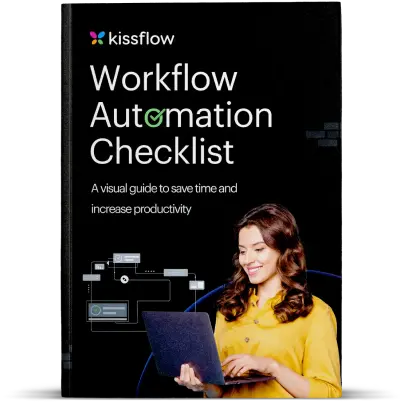
Workflow tools are transforming how businesses operate in 2026. According to Mordor Intelligence, the global workflow automation market reached $23.77 billion in 2025 and is forecast to hit $37.45 billion by 2030, growing at 9.52% annually. This explosive growth reflects a fundamental shift: businesses are abandoning manual processes in favour of intelligent automation systems that deliver measurable results.
What are workflow management tools?
Workflow management tools are software applications that automate tasks and streamline time-consuming business processes by eliminating manual dependencies and redundancies. These solutions use a systematic approach to managing and automating common business operations, generally requiring minimal coding expertise.
The best workflow management apps allow business users closest to processes to directly design, implement, and optimize workflows without constant IT intervention.
Modern workflow management and automation tools deliver benefits across multiple dimensions. They reduce manual errors by 40-75% compared to traditional processes, according to Kissflow's automation statistics. Teams using workflow systems report 15-35% improvements in employee satisfaction as workers are freed from repetitive administrative tasks.
Why your organization need a workflow management tool in 2026
The business case for workflow automation has never been stronger. Duke University research found that nearly 60% of businesses already run automation in at least one workflow today.
However, only 4% of firms have achieved full end-to-end automation, signaling massive opportunity for organizations to gain competitive advantage.
Key benefits of business workflow tools
Some of the key benefits and advantages of using a workflow management tool in a business organization are as follows,
Time Savings:
Workflow automation reduces repetitive tasks by 60-95%, freeing teams to focus on strategic initiatives. Payment automation alone saves mid-sized finance teams approximately 500 staff hours annually, according to Vena Solutions research.
Error Reduction:
Manual data entry and processing create costly mistakes. Automated workflows eliminate these errors through standardized processes and built-in validation rules.
Cost Efficiency:
IDC data shows that 20-30% of annual revenue evaporates through re-keying, duplicated effort, and lost approvals. Workflow tools recapture these losses.
Faster Decision-Making:
84% of finance professionals report quicker decisions after implementing digital workflows that surface real-time data.
Employee Morale:
Salesforce research indicates that 88% of workers using automation feel more satisfied in their roles, citing reduced drudge work as the primary factor.
How to choose the best workflow management solution
Selecting the right workflow tools requires evaluating several critical factors. Some of them are as follows,
1. Assess your workflow requirements
Start by mapping your current processes. Identify bottlenecks, approval chains, multi-departmental handoffs, and repetitive tasks. Document which workflows need automation first, whether it's invoice approvals, employee onboarding, customer service ticket routing, or project management.
2. Evaluate ease of use and learning curve
The best workflow management software features intuitive interfaces requiring minimal training. Look for drag-and-drop functionality, visual workflow builders, and pre-built templates. Solutions that force extensive coding or technical expertise create adoption barriers.
3. Prioritize automation capabilities
Advanced workflow systems should support dynamic role assignment, conditional branching, scheduled tasks, and trigger-based actions. The platform should handle both simple sequential workflows and complex multi-path processes with parallel approvals.
4. Verify integration compatibility
Your workflow tool must connect seamlessly with existing systems. Check for native integrations with email platforms, CRM software, ERP systems, project management tools, communication platforms like Slack or Microsoft Teams, and cloud storage solutions.
5. Consider customization flexibility
Business requirements evolve. Choose platforms offering custom fields, configurable forms, conditional logic, role-based permissions, and adaptable approval chains. Rigid systems create technical debt.
6. Review reporting and analytics
Robust workflow management systems provide real-time dashboards, audit trails, bottleneck identification, SLA tracking, and performance metrics. These insights drive continuous process improvement.
7. Confirm scalability
Select solutions that grow with your organization. The platform should handle increasing workflow volume, additional users, more complex processes, and expanded integrations without performance degradation.
8. Analyze total cost of ownership
Look beyond subscription fees. Factor in implementation costs, training expenses, integration costs, customization fees, and ongoing support charges. Calculate expected ROI based on time savings and efficiency gains.
9. Test security and compliance features
Enterprise workflow tools need robust security. Verify data encryption, role-based access controls, audit logging, compliance certifications (SOC 2, GDPR, HIPAA), and data residency options for regulated industries.
10. Leverage free trials
Most workflow software vendors offer trial periods. Use these to test real workflows, involve actual users, validate integration claims, and assess vendor support responsiveness before committing.
9 best online workflow management tools list compared in 2026
Let’s look at the top workflow management solutions and tools for 2026 to manage workflows more effectively.
- Kissflow
- Zoho Creator
- Creatio
- Nintex
- Pipefy
- Process street
- Bonitasoft
- Bizagi
- Integrify
| Feature / Attribute |
|
|
|
|
|
|
|

|
|---|---|---|---|---|---|---|---|---|
|
Best For
|
Handling IT backlogs and departmental workflows |
Microsoft-centric enterprises |
Zoho Suite users |
Enterprises needing process automation |
Organizations needing CRM + workflow |
Business process automation for teams |
Process modeling and automation |
Complex process automation |
|
Key Differentiator
|
Unified no-code and low-code platform; form-first approach; patented rules engine |
Integrates well with other Microsoft tools; powerful BI and automation |
Deluge scripting customization; works well within Zoho |
RPA and process mining capabilities |
CRM integration; flexible workflow configuration |
Kanban-centric UI; task assignment |
BPMN support; strong modeling capabilities |
Java/Groovy support; local development |
|
Typical Users
|
CIOs, IT managers, process owners |
IT teams in Microsoft ecosystems |
Zoho-centric businesses |
Process developers, enterprise architects |
Business teams with IT support |
Department managers |
IT-led business process teams |
IT developers |
|
Notable Limitations
|
Not ideal for Tier 1 enterprise apps |
Steep learning curve, fragmented modules, costly |
Limited external integrations; Deluge learning curve |
Complex UI; long time-to-value |
Developer mindset required; not fully no-code |
Limited API access; customization barriers |
Requires BPMN knowledge; complex implementation |
Steep learning curve; not for business users |
|
Pricing Tier
|
Mid-to-high, user-based pricing |
High, complex licensing |
Mid-range, usage-based |
High, feature-based licensing |
High, tiered plans |
Mid-range, per-user pricing |
High, consumption-based |
High, custom quotes |
1. Kissflow

Kissflow is a powerful yet simple low-code platform with workflow automation and business process management capabilities. Users can create workflows from scratch or choose a pre-built template. Kissflow has prebuilt workflow templates for HR, sales, finance, and other departments.
The drag-and-drop form builder helps users collect and store data, while automated notifications allow users to stay updated on workflow progress.
Why Kissflow
Kissflow allows business and IT users to build processes with little to no coding. The project and process management tool can streamline workflows, boosting productivity and efficiency. Admins can define user roles and permissions to manage governance while encouraging collaboration.
Case Study: Lumen Automotive Transforms Manufacturing Processes
Lumen, an Australian automotive manufacturer, revolutionized their manual processes with Kissflow's intuitive platform:
-
Automated 10+ critical processes, including Premium Freight Authority, Purchase Orders, and more
-
Successfully connected data across processes without duplication
-
Created custom management reports that leadership loved
-
Achieved measurable improvements in cost savings, tracking efficiency, and SLA adherence
-
Reduced delays and missing data across operations
"Kissflow is one of our main systems. It lets everyone have any form request that goes through multiple departments for actions."
— Madhuri Balimane, CI/LEAN Lead, Lumen
Read the full Lumen success story →

Top features of Kissflow workflow tool
- No-code/low-code application development: Users can build custom enterprise applications with minimal to no-code.
- Workflow and process automation: Users can execute and automate processes that respond quickly to changes without choking the IT teams.
- Structured and unstructured case management: Kissflow’s comprehensive reporting tools generate detailed reports, giving insights into processes and enabling users to make data-driven decisions.
- Advanced integrations: Users can seamlessly connect their workflows with internal and external systems.
- Contextual collaboration: Kissflow offers a centralized platform for all workflows, processes, projects, and communication, preventing switching between different tools.
- External portals: Users can create secure and customizable portals for seamless collaboration with external systems.
- Centralized governance dashboards: Admins can achieve complete governance over applications and users with detailed reports and logs.
Pros - Kissflow
- Custom scripting capabilities using JavaScript: Extend the functionality of applications and add custom features with JavaScript.
- Powerful integrations: Integrate your existing business tools seamlessly to manage tasks, processes, projects, and more.
- Boards for advanced case management: Automate complex processes and optimize case management with Kissflow boards.
- Custom role-based access management: Set permissions that allow users to build, update, or delete applications based on their roles within a team or organization.
- Built-in document generator: Create important business documents—invoices, contracts, communications, and more—with Kissflow’s prebuilt templates.

Experience the power of Kissflow firsthand
2. Zoho Creator

Image Souce: Capterra
Zoho Creator, a leading low-code development platform, offers a strong selection of pre-built apps and templates that streamline application development. Users can automate workflows to boost productivity, saving their organizations time and money.
The workflow software helps businesses digitize their operations without resorting to traditional development. They can manage their data and workflows, gain important insights from their databases, and get their apps running in minut
Top Features - Zoho Creator
-
Low-code app development: The intuitive interface allows business domain experts to build custom, low-code applications.
-
Workflow customization: Zoho Flow allows users to build smart integrations and connect apps to automate workflows.
-
Analytics: Zoho Analytics lets users analyze their data for advanced reporting and analysis, whether on the cloud or on-premises.
Pros - Zoho Creator
-
Works seamlessly with other Zoho products: Zoho Creator integrates seamlessly with all the other Zoho products.
-
Advanced analytics: Businesses that leverage Zoho analytics boost efficiency and productivity by optimizing processes and removing bottlenecks.
-
Reusable components built using Deluge: Zoho’s online scripting language, Deluge, enables users to add logic to applications incrementally, making the apps more powerful.
Cons - Zoho Creator
-
Limited integrations outside Zoho products: Zoho Creator offers integrations with popular tools like Gsuite and Microsoft 365, but API integrations are limited.
-
Platform updates often affect applications: Sometimes, updates made by Zoho Creator require users to develop new applications.
-
Users must learn Deluge: While Zoho offers low-code development, users must learn Deluge, Zoho's proprietary development language, to add custom capabilities to their apps.
3. Creatio

Image Souce: Capterra
Creatio is a low-code/no-code platform that allows businesses to automate workflows and build applications. It provides industry workflows for 20 verticals and marketplace add-ons. Studio Creatio, its no-code platform, enables users to create powerful business applications quickly.
All Creatio products are powered with no-code and low-code technology to help enterprises digitize workflows, enhance customer experiences, and boost efficiency across business units
Top Features - Creatio
-
Process management: Businesses can analyze the performance of processes, identify bottlenecks, and make changes to optimize workflows.
-
CRM: It is possible to organize, automate, and synchronize every facet of customer interaction.
-
Marketing and sales automation: Marketing Creatio and Sales Creatio help sales reps and marketers find, engage, and convert prospects.
Pros - Creatio
-
No-code process management: Creatio’s no-code tool allows users to implement integrations and workflow automation without writing a single line of code.
-
Easy deployment: Applications built with Creatio can be deployed on-premises in the cloud or as a hybrid solution.
-
Custom solutions for sales, marketing, and services: Ready-to-use industry workflows for sales, marketing, and service allow users to automate processes, saving time and resources easily.
"Intuitive interface makes it so easy and enjoyable to work with the system. Any user can learn and start using the application fast. It saves you a lot of time since your staff adopt a new software faster. Additionally, it is the efficiency that we gained thanks to the unique and powerful tools for customer management with BPM engine. This engine made the work of our staff much easier and more efficient. It saves a lot of time and minimizes errors."
- Anton C.
IT Systems Development Manager Pharmaceuticals
Cons - Creatio
-
Requires BPMN knowledge: Users need some BPMN knowledge to automate routine processes and create custom business logic, such as integrations and custom UIs.
-
Primarily for CRMs: Creatio heavily focuses on CRM and is not a dedicated low-code/no-code development platform for workflow automation.
-
Requires a partner or system integrator (SI) to implement: Businesses using Creatio need an SI or partner to connect internal and external disparate systems. Implementation can’t happen without partners.
4. Nintex

Image Souce: Capterra
The user-friendly workflow automation platform allows businesses to automate their processes rapidly. It has customizable workflows, a drag-and-drop design, and real-time analytics that help enterprises save time and increase efficiency.
With Nintex Automation Cloud Services, users can leverage data-driven insights to optimize processes.
Top Features - Nintex
- Process management: The workflow management tool helps organizations manage, automate, and optimize their business processes.
- Document management: Nintex automates the creation of personalized, data-merged, branded documents like sales proposals, contracts, invoices, and reports.
- Reporting and analytics: Prebuilt and customizable analytics dashboards provide actionable insights into all the automation running across an organization.
Pros - Nintex
-
Robotic Process Automation (RPA): Businesses can automate repetitive, mundane, or labor-intensive tasks to improve efficiency and agility.
-
Process mining and discovery: Organizations can mine data from the platform to analyze process performance and identify areas for improvement.
-
Document generation for SalesForce: Nintex for Salesforce lets users instantly transform Salesforce data into mission-critical documents–from contracts to invoices.
Cons - Nintex
-
Complex for business users:Nintex has a steep learning curve and isn’t as intuitive for those new to process automation.
-
Lack of data storage: Nintex doesn't store data. Users must rely on external data storage applications like Salesforce and SharePoint.
-
Does not offer custom user experiences: Users have limited customization options as the platform only offers system-defined user experience.
5. Pipefy

Image Souce: Capterra
Pipefy is a workflow management platform that allows businesses to build, automate, optimize, and orchestrate different processes to boost operational efficiency across different departments. Business users can standardize processes and workflows without any IT support.
Top Features - Pipefy
-
Drag-and-drop workflow builder: It has a simple and intuitive drag-and-drop builder that makes it easy for users to design and deploy custom processes.
-
Automation rules: Users can set automation rules to trigger actions based on predefined conditions, minimizing manual intervention and accelerating task completion.
-
Reporting and analytics: Pipefy's real-time dashboards allow users to monitor process performance and get visual insights into tasks, bottlenecks, and overall progress.
Pros - Pipefy
-
Free plan for up to 10 users: It provides a free version with limited features for up to 10 users. Small teams can use the plan to boost efficiency and productivity.
-
Templates for popular use cases: Pipefy offers templates that can be fully customized or used as they are.
-
Intuitive, user-friendly interface: The platform’s interface makes it easy to get started, and users can navigate complex features without feeling overwhelmed.
"Time should be less to claim the Insurance for users. It's beneficial for those who are working remotely. Our Organisation is using it for managing claims of Travel, Mobile bills, Internet Bills, Medical Bills, and many other things and also for reimbursement purposes. We can use it for claiming our insurance in less time."
- Akshata P.
Associate Technical Consultant
Cons - Pipefy
- No support for rigidly structured processes: The complexity level of pipes created on the platform significantly increases the work required to manage them.
- Difficult to add multiple users: Adding multiple users to one workflow instance is difficult. It makes identifying individual users challenging.
- Limited customization options: While Pipefy offers many workflow management features, customization options are limited compared to other tools.
6. Process Street

Image Souce: Capterra
Process Street is a workflow tool that offers a powerful way to manage recurring checklists and procedures. Powered by AI, it helps teams transform their core processes into powerful no-code workflows. Users in different industries can build numerous workflows, from content approvals to tenant screening.
Top Features - Process Street
-
Drag-and-drop workflow builder: It lets users easily create the exact workflows they need, from the simplest to the most complex.
-
Customizable templates: Users can customize templates with instructions, images, videos, and attachments.
-
Reporting and analytics: The reporting dashboard displays key metrics and insights, helping users understand workflow performance and make data-driven decisions.
Pros - Process Street
-
Built-in document editor: It helps users capture, edit, organize, and share documents to establish team knowledge.
-
Scalable: The Enterprise plan allows users to easily expand their processes by adding more tools and participants, maximizing process scalability.
-
Custom solutions: Process Street users can build customized apps—for HR, IT, service teams, and other business functions—that work on desktop and mobile devices
Cons - Process Street
- Limited customization: Sometimes, workflow templates cannot be customized to create a complete workflow.
- No custom user experience: Process Street doesn’t allow for greater customization and flexibility. Businesses can’t customize the platform to suit their individual needs and preferences.
- Limited governance capabilities: Features like ADA/WCAG compliance and localization are unavailable. Basic features like access control and single sign-on (SSO) are available on more expensive plans.
7. Bonitasoft

Image Souce: Capterra
Bonitasoft helps companies worldwide create agile applications for continuous and incremental improvement. The platform accelerates app development and production by offering visual programming and coding tools. It promotes collaboration between IT and business teams.
Top Features - Bonitasoft
- Process designer: The UI designer lets users create and update forms and processes for business applications.
- Case management: It provides an agile and adaptive approach to case management driven by data instead of process.
- Workflow automation: The Bonita Test Toolkit streamlines the development and deployment of simple and complex automation projects.
Pros - Bonitasoft
-
Open source: Developers can add their code to the platform to unlock the full potential of applications.
-
Ideal for developers: Bonitasoft offers coding capabilities for accelerating the development, production, and maintenance of automation projects.
-
Workflow automation and process design: Users can model and monitor business processes to streamline operations and accelerate the development and deployment.
"Bonita just made sense. The more you learn and put it to use the more you seems to be working with nothing because it works as intended. It is not that the piece has no problems. It does, as any software nowadays does. Sometimes you need to wait for a patch to come out and sometimes you just have to find and alternate ways of doing things but you never left at a dead end. The heavy IDE makes thing slugish at times but once it is deployed, the workflow processes are a rocket."
- Fábio D.
Product Manager, Computer Software
Cons - Bonitasoft
-
Requires system installation: Users must install Bonita Studio on Windows, Linux, or Mac operating systems to use the platform.
-
Not ideal for business users: Bonitasoft has an integrated development environment that’s quite technical and unsuitable for business users.
-
Requires BPMN knowledge: Bonita supports BPMN 2.0, and users must apply the modeling language to visualize business processes and make workflows more efficient.
8. Bizagi

Image Souce: Capterra
It is a low-code/no-code process automation platform that aligns IT with business, letting users rapidly build cloud apps. From modeling to automation and deployment, Bizagi supports the complete application lifecycle to make continuous improvement a reality. Users can monitor and continuously improve their business processes on the comprehensive reporting platform with real-time analytics.
Check out: Kissflow vs Bizagi: A Detailed Comparison
Top Features - Bizagi
- Process automation: The intelligent process automation software lets users merge people, information, and systems to achieve more efficient and agile workflows.
- Application development: Bizagi empowers users to build enterprise apps that align with their business goals and quality standards.
- Process modeling: With the Bizagi Modeler, enterprises can create and document business processes to better understand each step and identify process improvement opportunities.
Pros - Bizagi
- Process modeling and mapping: Business users and developers can map and model processes to optimize inefficiencies and bottlenecks.
- Suitable for structured and unstructured case management: Bizagi facilitates seamless case management and resolution.
- No-code application development: Bizagi uses no-code as a foundation for process automation, providing a short learning curve for process creators and end users.
Cons - Bizagi
-
Requires BPMN knowledge: Bizagi users must apply BPMN to model and document business processes.
-
Not for complex workflows: Technical knowledge is needed when building highly customized workflows with advanced use cases.
-
Not built on a modern tech stack: Bizagi’s core technology is on-premises, and web apps built on the platform may not be easy to maintain or scale.
9. Integrify

Image Souce: Capterra
Integrify is a low-code/no-code workflow solution for organizations looking to automate their business processes and boost productivity. Users can automate complex processes and accelerate digital transformation. The platform provides tools for designing and building automated HR, operations, finance, IT, sales, marketing, and more workflows. Its also possible to leverage Integrify’s consulting and development services to expand their use of workflow automation.
Top Features - Integrify
- Form designer: Any user conversant with a word processing tool can manipulate a form's layout using questions, fonts, custom styles, and more.
- Reporting: Integrify tracks all activity in automated workflows, ensuring they perform to expected standards.
- Process builder: Designing automated workflow processes is as easy as dragging and dropping elements. Integrify’s workflow builder is designed for flexibility and rapid design.
Pros - Integrify
-
Developer-friendly: Integrify is built for developers as it is robust enough to handle integration and customization.
-
Scalable applications: The workflow tool puts development in the hands of users, enabling them to build scalable web applications.
- Open REST API and AWS Lambda integrations: Custom workflow connections are powered by Integrify’s open API and AWS Lambda integration.
"Intuitive interface makes it so easy and enjoyable to work with the system. Any user can learn and start using the application fast. It saves you a lot of time since your staff adopt a new software faster. Additionally, it is the efficiency that we gained thanks to the unique and powerful tools for customer management with BPM engine. This engine made the work of our staff much easier and more efficient. It saves a lot of time and minimizes errors."
- Anton C
IT Systems Development Manager, Pharmaceuticals
Cons - Integrify
-
Not suitable for business users: Integrify has a complex UI, and finding relevant features can be challenging.
-
Limited out-of-the-box integrations: While Integrify has REST API capability, integrations with third-party applications can be complex.
-
Requires custom integrations for full functionality: Users who want to build and integrate workflows into core applications must use custom integrations.
Choosing the right workflow tool for your organization
The workflow automation market offers abundant choices spanning simple task management to enterprise business process management platforms. Selection depends on your organization's specific needs, technical capabilities, and strategic objectives.
For mid-market to enterprise organizations seeking comprehensive, no-code workflow automation with strong governance, Kissflow's workflow platform delivers proven results across industries. Its combination of visual workflow design, extensive pre-built templates, and enterprise security makes it particularly strong for companies handling complex, multi-departmental workflows.
The transformation from manual to automated workflows delivers measurable benefits: 30% productivity increases, 40-75% error reduction, and 248% three-year ROI. These results explain why 80% of organizations plan to adopt intelligent automation by 2025.
Ready to transform your workflows? Sign up for Kissflow to discover why thousands of organizations trust our platform for mission-critical process automation. Compare features, explore pre-built templates, and see firsthand how workflow automation can eliminate bottlenecks while improving team productivity.
FAQs on workflow tools
1. What is the difference between workflow tools and project management software?
Workflow tools focus on automating repetitive business processes with defined sequences of tasks, approvals, and rules. They excel at routing work items through predetermined paths based on business logic. Examples include invoice approvals, employee onboarding, and purchase requisitions.
Project management software emphasizes planning, scheduling, and coordinating unique projects with distinct timelines, resources, and deliverables. Projects have defined start and end dates, while workflows are ongoing, repeatable processes.
2. Can small businesses benefit from workflow management tools, or are they only for enterprises?
Small businesses gain significant benefits from workflow automation. According to research, small and medium-sized enterprises will grow at 10.31% CAGR through 2030, faster than large enterprises, indicating strong SMB adoption.
3. What training is required for employees to use workflow management tools effectively?
Modern workflow platforms prioritize intuitive interfaces minimizing training needs. Studies show that 88% of users report higher satisfaction with their work when using automation tools, partly because they're easy to adopt.
4. What's the difference between workflow automation tools and BPM software, and which one does my business actually need?
Workflow automation tools focus on digitizing and automating specific, repeatable processes like approvals, requests, and task routing with minimal technical expertise required. BPM (Business Process Management) software provides comprehensive capabilities for modeling, analyzing, optimizing, and automating complex, end-to-end business processes across entire organizations.
5. Can I integrate workflow management software with my existing tools like Salesforce, Microsoft 365, SAP, and Google Workspace without hiring developers?
Most modern workflow platforms offer pre-built connectors and integrations requiring zero coding for popular business applications. Platforms like Microsoft Power Automate, Kissflow, and Zapier provide hundreds of native integrations that connect through simple authentication and configuration steps business users can handle independently.
Ready to automate your workflow with Kissflow?

Kissflow's Complete Guide To Workflow Automation
Thank you for downloading the ebook!
Related Articles











